Environmental Science Report: Theories, Strategies, and Species
VerifiedAdded on 2020/11/23
|13
|4498
|449
Report
AI Summary
This environmental science report delves into the field of botany, exploring microevolution, natural selection, and adaptation. It examines theories related to gene flow, isolation, and hybridization, crucial for understanding plant evolution. The report assesses environmental strategies and management processes at both national and global levels, focusing on securing species survival. It includes the identification and description of various plant species, including bryophytes, and highlights the significance of simple green plants to human survival. Furthermore, the report evaluates the ecological relevance of these plants and details significant adaptations for terrestrial plants. The importance of seed survival and its environmental and human impacts is also discussed, along with different strategies for survival. Finally, the report identifies and describes the structure and function of bacteria and viruses, providing a comprehensive overview of botanical evolution.

Environmental Science
Paraphrase This Document
Need a fresh take? Get an instant paraphrase of this document with our AI Paraphraser
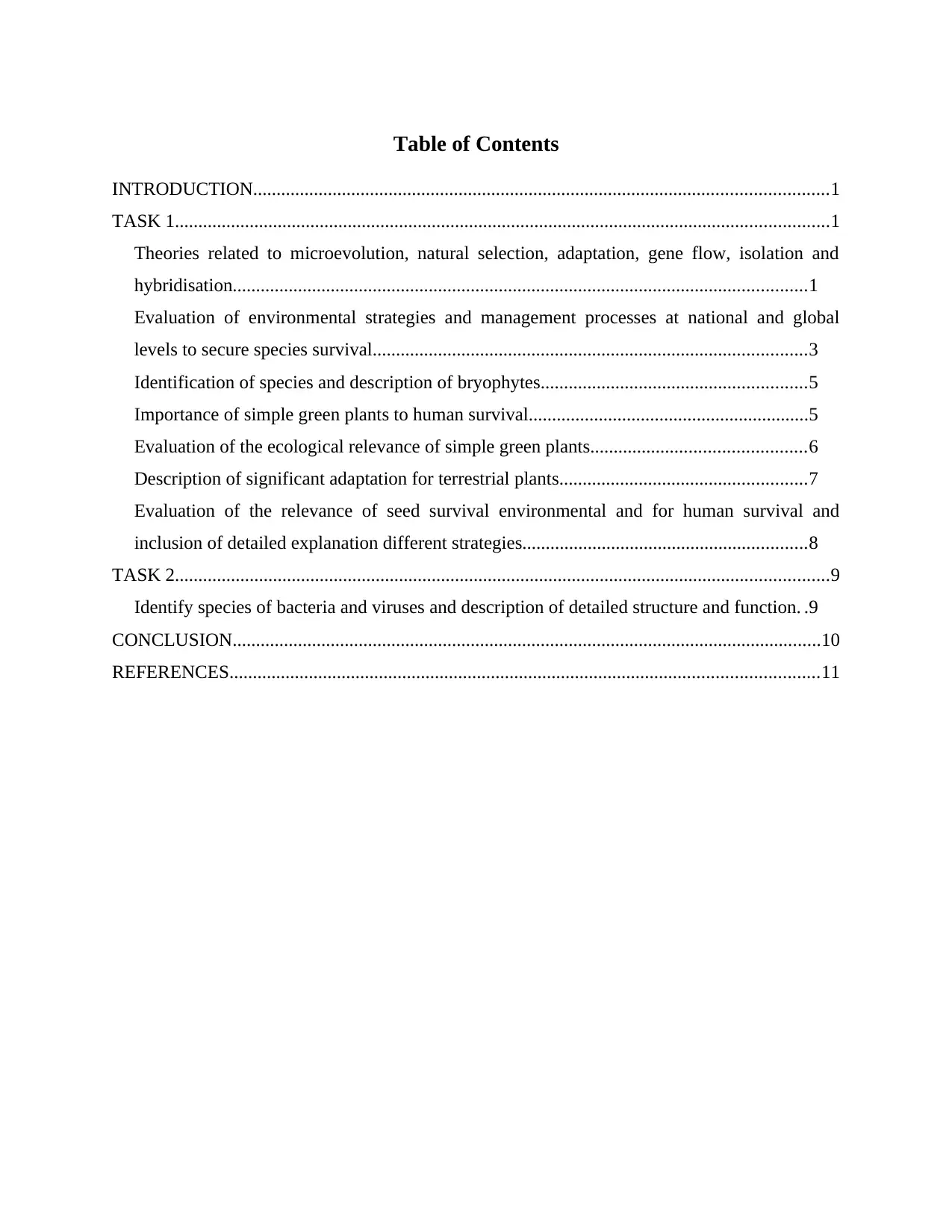
Table of Contents
INTRODUCTION...........................................................................................................................1
TASK 1............................................................................................................................................1
Theories related to microevolution, natural selection, adaptation, gene flow, isolation and
hybridisation...........................................................................................................................1
Evaluation of environmental strategies and management processes at national and global
levels to secure species survival.............................................................................................3
Identification of species and description of bryophytes.........................................................5
Importance of simple green plants to human survival............................................................5
Evaluation of the ecological relevance of simple green plants..............................................6
Description of significant adaptation for terrestrial plants.....................................................7
Evaluation of the relevance of seed survival environmental and for human survival and
inclusion of detailed explanation different strategies.............................................................8
TASK 2............................................................................................................................................9
Identify species of bacteria and viruses and description of detailed structure and function. .9
CONCLUSION..............................................................................................................................10
REFERENCES..............................................................................................................................11
INTRODUCTION...........................................................................................................................1
TASK 1............................................................................................................................................1
Theories related to microevolution, natural selection, adaptation, gene flow, isolation and
hybridisation...........................................................................................................................1
Evaluation of environmental strategies and management processes at national and global
levels to secure species survival.............................................................................................3
Identification of species and description of bryophytes.........................................................5
Importance of simple green plants to human survival............................................................5
Evaluation of the ecological relevance of simple green plants..............................................6
Description of significant adaptation for terrestrial plants.....................................................7
Evaluation of the relevance of seed survival environmental and for human survival and
inclusion of detailed explanation different strategies.............................................................8
TASK 2............................................................................................................................................9
Identify species of bacteria and viruses and description of detailed structure and function. .9
CONCLUSION..............................................................................................................................10
REFERENCES..............................................................................................................................11
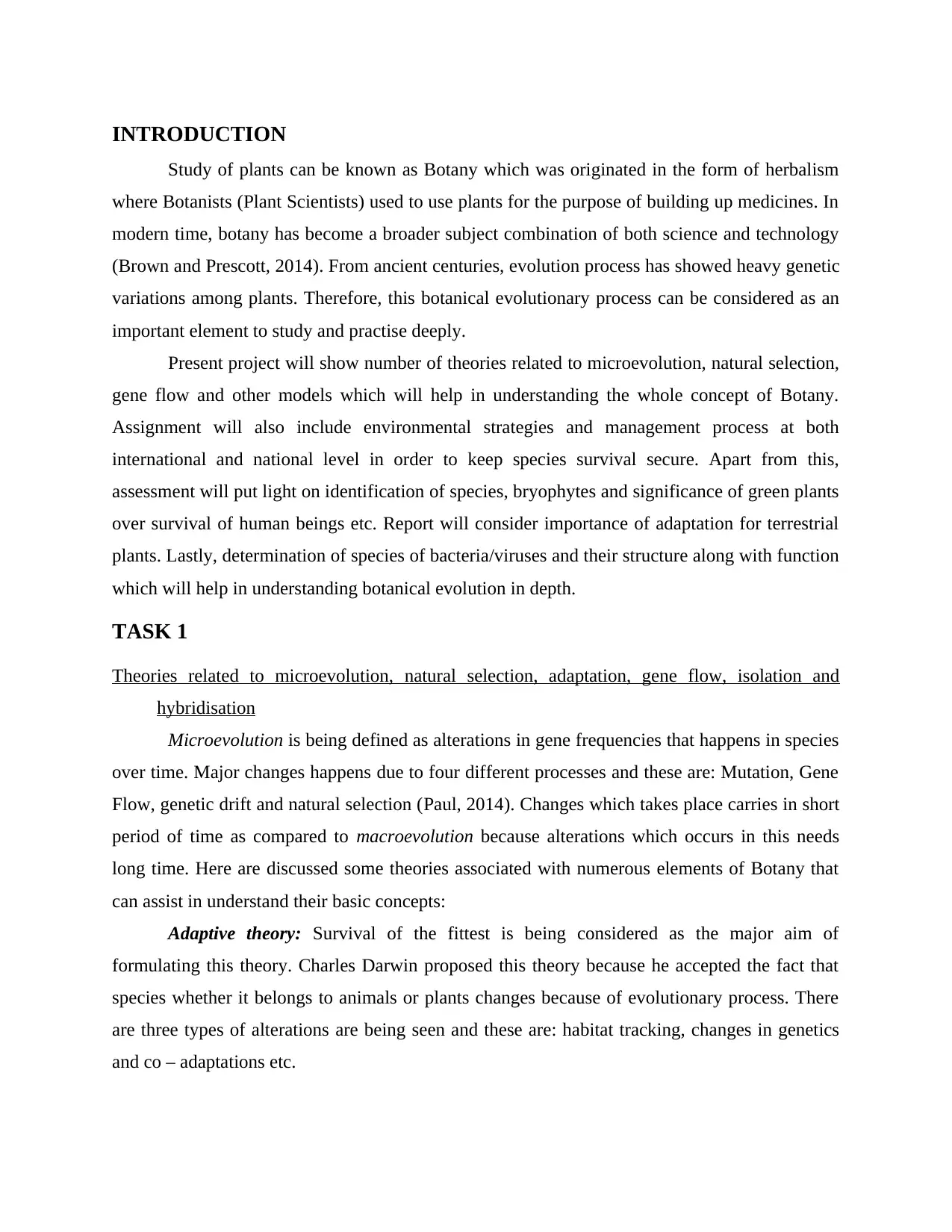
INTRODUCTION
Study of plants can be known as Botany which was originated in the form of herbalism
where Botanists (Plant Scientists) used to use plants for the purpose of building up medicines. In
modern time, botany has become a broader subject combination of both science and technology
(Brown and Prescott, 2014). From ancient centuries, evolution process has showed heavy genetic
variations among plants. Therefore, this botanical evolutionary process can be considered as an
important element to study and practise deeply.
Present project will show number of theories related to microevolution, natural selection,
gene flow and other models which will help in understanding the whole concept of Botany.
Assignment will also include environmental strategies and management process at both
international and national level in order to keep species survival secure. Apart from this,
assessment will put light on identification of species, bryophytes and significance of green plants
over survival of human beings etc. Report will consider importance of adaptation for terrestrial
plants. Lastly, determination of species of bacteria/viruses and their structure along with function
which will help in understanding botanical evolution in depth.
TASK 1
Theories related to microevolution, natural selection, adaptation, gene flow, isolation and
hybridisation
Microevolution is being defined as alterations in gene frequencies that happens in species
over time. Major changes happens due to four different processes and these are: Mutation, Gene
Flow, genetic drift and natural selection (Paul, 2014). Changes which takes place carries in short
period of time as compared to macroevolution because alterations which occurs in this needs
long time. Here are discussed some theories associated with numerous elements of Botany that
can assist in understand their basic concepts:
Adaptive theory: Survival of the fittest is being considered as the major aim of
formulating this theory. Charles Darwin proposed this theory because he accepted the fact that
species whether it belongs to animals or plants changes because of evolutionary process. There
are three types of alterations are being seen and these are: habitat tracking, changes in genetics
and co – adaptations etc.
Study of plants can be known as Botany which was originated in the form of herbalism
where Botanists (Plant Scientists) used to use plants for the purpose of building up medicines. In
modern time, botany has become a broader subject combination of both science and technology
(Brown and Prescott, 2014). From ancient centuries, evolution process has showed heavy genetic
variations among plants. Therefore, this botanical evolutionary process can be considered as an
important element to study and practise deeply.
Present project will show number of theories related to microevolution, natural selection,
gene flow and other models which will help in understanding the whole concept of Botany.
Assignment will also include environmental strategies and management process at both
international and national level in order to keep species survival secure. Apart from this,
assessment will put light on identification of species, bryophytes and significance of green plants
over survival of human beings etc. Report will consider importance of adaptation for terrestrial
plants. Lastly, determination of species of bacteria/viruses and their structure along with function
which will help in understanding botanical evolution in depth.
TASK 1
Theories related to microevolution, natural selection, adaptation, gene flow, isolation and
hybridisation
Microevolution is being defined as alterations in gene frequencies that happens in species
over time. Major changes happens due to four different processes and these are: Mutation, Gene
Flow, genetic drift and natural selection (Paul, 2014). Changes which takes place carries in short
period of time as compared to macroevolution because alterations which occurs in this needs
long time. Here are discussed some theories associated with numerous elements of Botany that
can assist in understand their basic concepts:
Adaptive theory: Survival of the fittest is being considered as the major aim of
formulating this theory. Charles Darwin proposed this theory because he accepted the fact that
species whether it belongs to animals or plants changes because of evolutionary process. There
are three types of alterations are being seen and these are: habitat tracking, changes in genetics
and co – adaptations etc.
⊘ This is a preview!⊘
Do you want full access?
Subscribe today to unlock all pages.

Trusted by 1+ million students worldwide
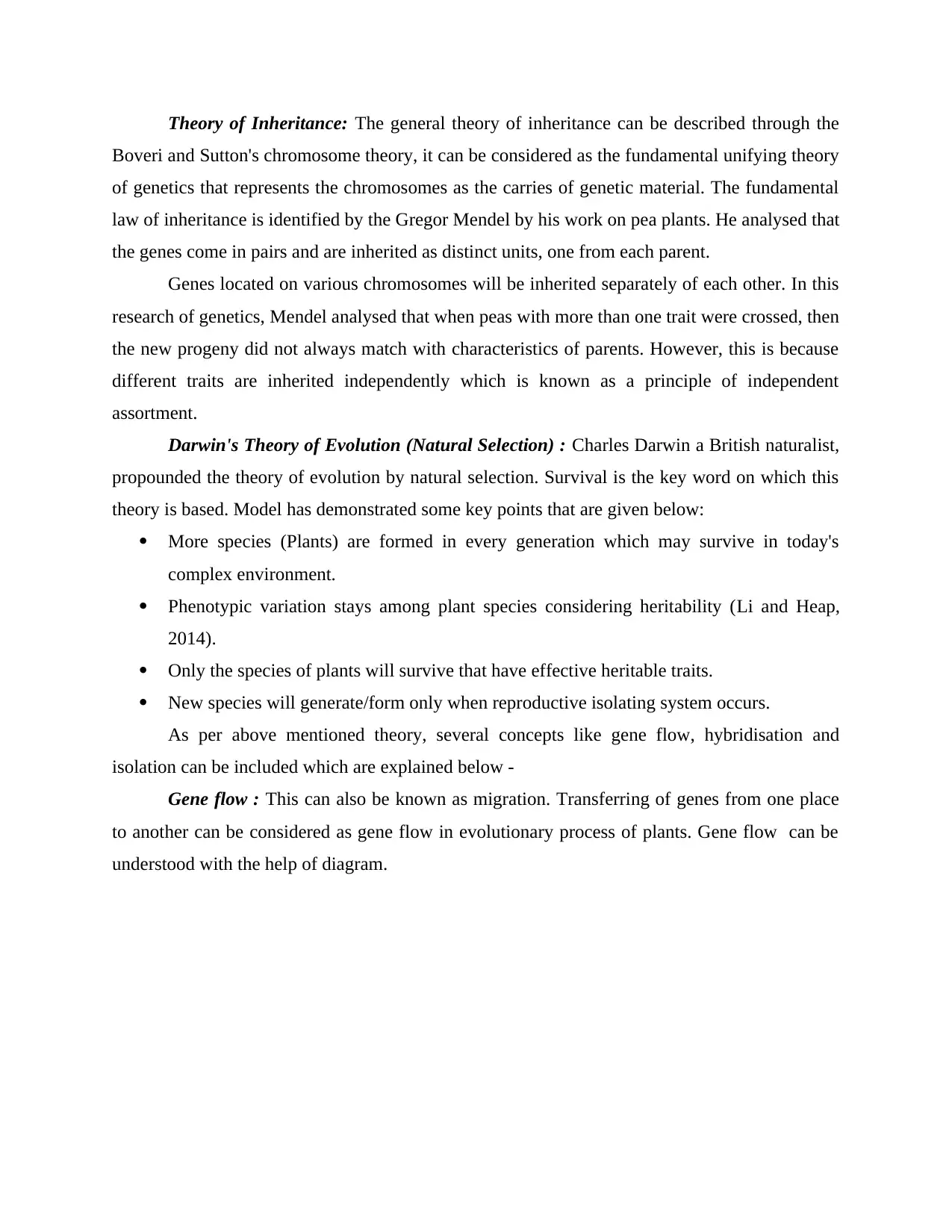
Theory of Inheritance: The general theory of inheritance can be described through the
Boveri and Sutton's chromosome theory, it can be considered as the fundamental unifying theory
of genetics that represents the chromosomes as the carries of genetic material. The fundamental
law of inheritance is identified by the Gregor Mendel by his work on pea plants. He analysed that
the genes come in pairs and are inherited as distinct units, one from each parent.
Genes located on various chromosomes will be inherited separately of each other. In this
research of genetics, Mendel analysed that when peas with more than one trait were crossed, then
the new progeny did not always match with characteristics of parents. However, this is because
different traits are inherited independently which is known as a principle of independent
assortment.
Darwin's Theory of Evolution (Natural Selection) : Charles Darwin a British naturalist,
propounded the theory of evolution by natural selection. Survival is the key word on which this
theory is based. Model has demonstrated some key points that are given below:
More species (Plants) are formed in every generation which may survive in today's
complex environment.
Phenotypic variation stays among plant species considering heritability (Li and Heap,
2014).
Only the species of plants will survive that have effective heritable traits.
New species will generate/form only when reproductive isolating system occurs.
As per above mentioned theory, several concepts like gene flow, hybridisation and
isolation can be included which are explained below -
Gene flow : This can also be known as migration. Transferring of genes from one place
to another can be considered as gene flow in evolutionary process of plants. Gene flow can be
understood with the help of diagram.
Boveri and Sutton's chromosome theory, it can be considered as the fundamental unifying theory
of genetics that represents the chromosomes as the carries of genetic material. The fundamental
law of inheritance is identified by the Gregor Mendel by his work on pea plants. He analysed that
the genes come in pairs and are inherited as distinct units, one from each parent.
Genes located on various chromosomes will be inherited separately of each other. In this
research of genetics, Mendel analysed that when peas with more than one trait were crossed, then
the new progeny did not always match with characteristics of parents. However, this is because
different traits are inherited independently which is known as a principle of independent
assortment.
Darwin's Theory of Evolution (Natural Selection) : Charles Darwin a British naturalist,
propounded the theory of evolution by natural selection. Survival is the key word on which this
theory is based. Model has demonstrated some key points that are given below:
More species (Plants) are formed in every generation which may survive in today's
complex environment.
Phenotypic variation stays among plant species considering heritability (Li and Heap,
2014).
Only the species of plants will survive that have effective heritable traits.
New species will generate/form only when reproductive isolating system occurs.
As per above mentioned theory, several concepts like gene flow, hybridisation and
isolation can be included which are explained below -
Gene flow : This can also be known as migration. Transferring of genes from one place
to another can be considered as gene flow in evolutionary process of plants. Gene flow can be
understood with the help of diagram.
Paraphrase This Document
Need a fresh take? Get an instant paraphrase of this document with our AI Paraphraser
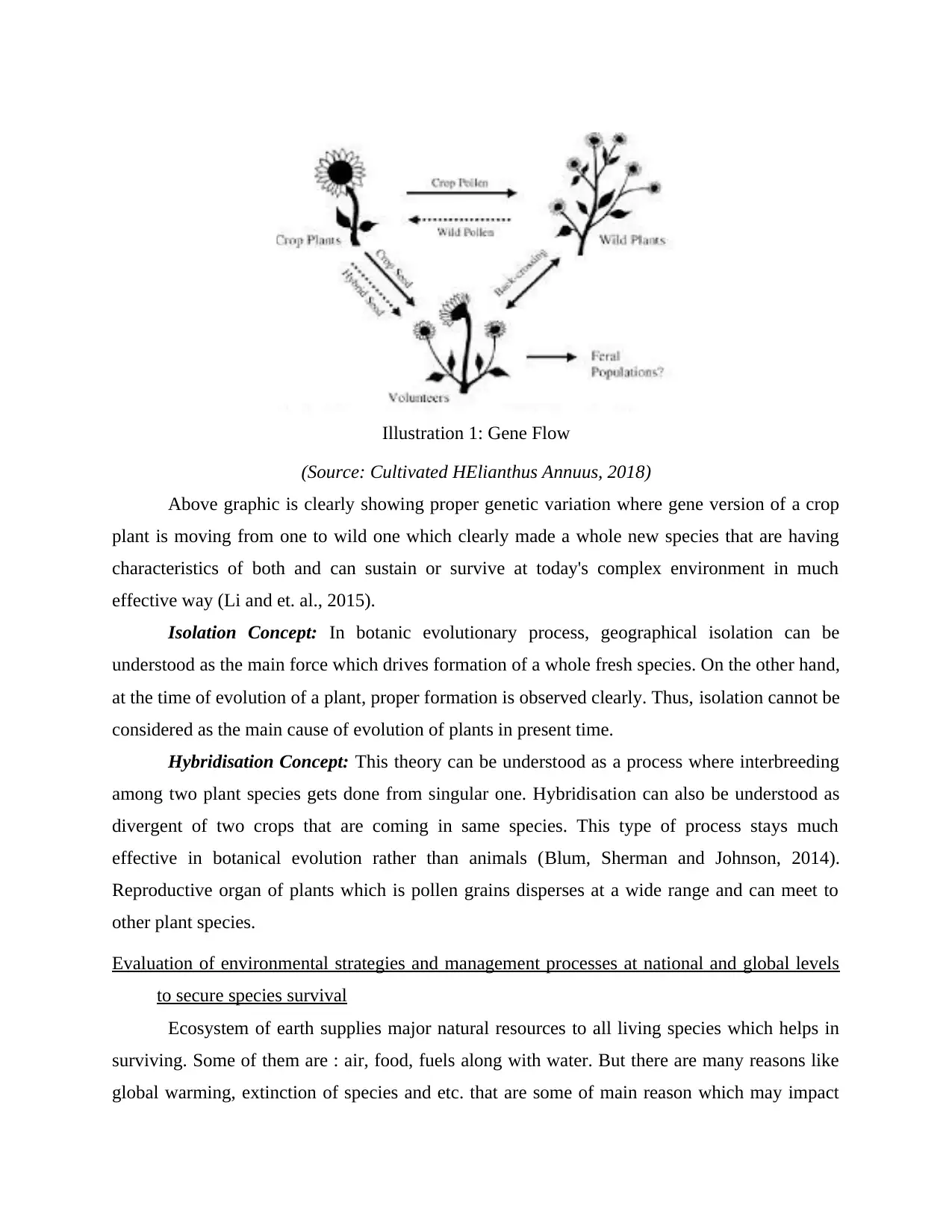
(Source: Cultivated HElianthus Annuus, 2018)
Above graphic is clearly showing proper genetic variation where gene version of a crop
plant is moving from one to wild one which clearly made a whole new species that are having
characteristics of both and can sustain or survive at today's complex environment in much
effective way (Li and et. al., 2015).
Isolation Concept: In botanic evolutionary process, geographical isolation can be
understood as the main force which drives formation of a whole fresh species. On the other hand,
at the time of evolution of a plant, proper formation is observed clearly. Thus, isolation cannot be
considered as the main cause of evolution of plants in present time.
Hybridisation Concept: This theory can be understood as a process where interbreeding
among two plant species gets done from singular one. Hybridisation can also be understood as
divergent of two crops that are coming in same species. This type of process stays much
effective in botanical evolution rather than animals (Blum, Sherman and Johnson, 2014).
Reproductive organ of plants which is pollen grains disperses at a wide range and can meet to
other plant species.
Evaluation of environmental strategies and management processes at national and global levels
to secure species survival
Ecosystem of earth supplies major natural resources to all living species which helps in
surviving. Some of them are : air, food, fuels along with water. But there are many reasons like
global warming, extinction of species and etc. that are some of main reason which may impact
Illustration 1: Gene Flow
Above graphic is clearly showing proper genetic variation where gene version of a crop
plant is moving from one to wild one which clearly made a whole new species that are having
characteristics of both and can sustain or survive at today's complex environment in much
effective way (Li and et. al., 2015).
Isolation Concept: In botanic evolutionary process, geographical isolation can be
understood as the main force which drives formation of a whole fresh species. On the other hand,
at the time of evolution of a plant, proper formation is observed clearly. Thus, isolation cannot be
considered as the main cause of evolution of plants in present time.
Hybridisation Concept: This theory can be understood as a process where interbreeding
among two plant species gets done from singular one. Hybridisation can also be understood as
divergent of two crops that are coming in same species. This type of process stays much
effective in botanical evolution rather than animals (Blum, Sherman and Johnson, 2014).
Reproductive organ of plants which is pollen grains disperses at a wide range and can meet to
other plant species.
Evaluation of environmental strategies and management processes at national and global levels
to secure species survival
Ecosystem of earth supplies major natural resources to all living species which helps in
surviving. Some of them are : air, food, fuels along with water. But there are many reasons like
global warming, extinction of species and etc. that are some of main reason which may impact
Illustration 1: Gene Flow
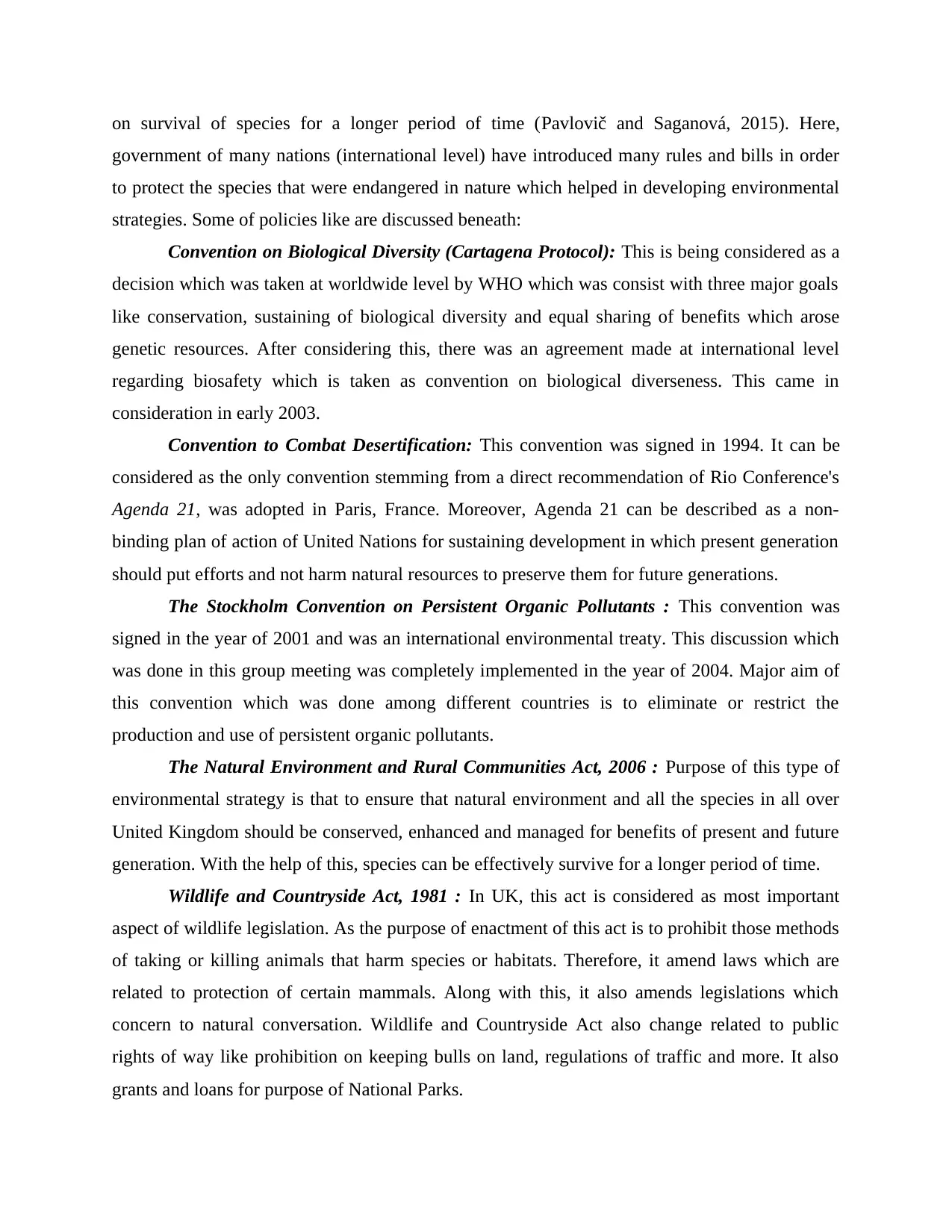
on survival of species for a longer period of time (Pavlovič and Saganová, 2015). Here,
government of many nations (international level) have introduced many rules and bills in order
to protect the species that were endangered in nature which helped in developing environmental
strategies. Some of policies like are discussed beneath:
Convention on Biological Diversity (Cartagena Protocol): This is being considered as a
decision which was taken at worldwide level by WHO which was consist with three major goals
like conservation, sustaining of biological diversity and equal sharing of benefits which arose
genetic resources. After considering this, there was an agreement made at international level
regarding biosafety which is taken as convention on biological diverseness. This came in
consideration in early 2003.
Convention to Combat Desertification: This convention was signed in 1994. It can be
considered as the only convention stemming from a direct recommendation of Rio Conference's
Agenda 21, was adopted in Paris, France. Moreover, Agenda 21 can be described as a non-
binding plan of action of United Nations for sustaining development in which present generation
should put efforts and not harm natural resources to preserve them for future generations.
The Stockholm Convention on Persistent Organic Pollutants : This convention was
signed in the year of 2001 and was an international environmental treaty. This discussion which
was done in this group meeting was completely implemented in the year of 2004. Major aim of
this convention which was done among different countries is to eliminate or restrict the
production and use of persistent organic pollutants.
The Natural Environment and Rural Communities Act, 2006 : Purpose of this type of
environmental strategy is that to ensure that natural environment and all the species in all over
United Kingdom should be conserved, enhanced and managed for benefits of present and future
generation. With the help of this, species can be effectively survive for a longer period of time.
Wildlife and Countryside Act, 1981 : In UK, this act is considered as most important
aspect of wildlife legislation. As the purpose of enactment of this act is to prohibit those methods
of taking or killing animals that harm species or habitats. Therefore, it amend laws which are
related to protection of certain mammals. Along with this, it also amends legislations which
concern to natural conversation. Wildlife and Countryside Act also change related to public
rights of way like prohibition on keeping bulls on land, regulations of traffic and more. It also
grants and loans for purpose of National Parks.
government of many nations (international level) have introduced many rules and bills in order
to protect the species that were endangered in nature which helped in developing environmental
strategies. Some of policies like are discussed beneath:
Convention on Biological Diversity (Cartagena Protocol): This is being considered as a
decision which was taken at worldwide level by WHO which was consist with three major goals
like conservation, sustaining of biological diversity and equal sharing of benefits which arose
genetic resources. After considering this, there was an agreement made at international level
regarding biosafety which is taken as convention on biological diverseness. This came in
consideration in early 2003.
Convention to Combat Desertification: This convention was signed in 1994. It can be
considered as the only convention stemming from a direct recommendation of Rio Conference's
Agenda 21, was adopted in Paris, France. Moreover, Agenda 21 can be described as a non-
binding plan of action of United Nations for sustaining development in which present generation
should put efforts and not harm natural resources to preserve them for future generations.
The Stockholm Convention on Persistent Organic Pollutants : This convention was
signed in the year of 2001 and was an international environmental treaty. This discussion which
was done in this group meeting was completely implemented in the year of 2004. Major aim of
this convention which was done among different countries is to eliminate or restrict the
production and use of persistent organic pollutants.
The Natural Environment and Rural Communities Act, 2006 : Purpose of this type of
environmental strategy is that to ensure that natural environment and all the species in all over
United Kingdom should be conserved, enhanced and managed for benefits of present and future
generation. With the help of this, species can be effectively survive for a longer period of time.
Wildlife and Countryside Act, 1981 : In UK, this act is considered as most important
aspect of wildlife legislation. As the purpose of enactment of this act is to prohibit those methods
of taking or killing animals that harm species or habitats. Therefore, it amend laws which are
related to protection of certain mammals. Along with this, it also amends legislations which
concern to natural conversation. Wildlife and Countryside Act also change related to public
rights of way like prohibition on keeping bulls on land, regulations of traffic and more. It also
grants and loans for purpose of National Parks.
⊘ This is a preview!⊘
Do you want full access?
Subscribe today to unlock all pages.

Trusted by 1+ million students worldwide
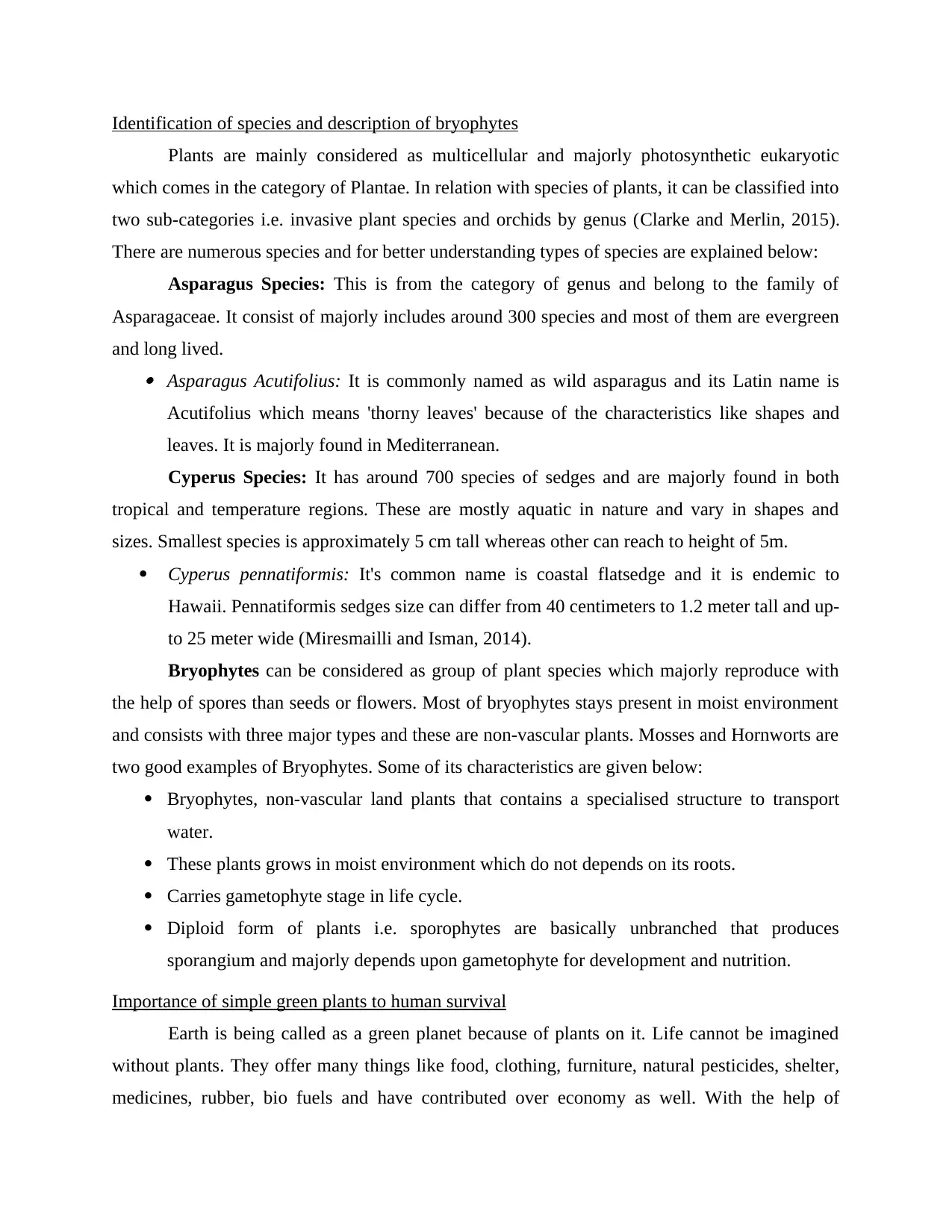
Identification of species and description of bryophytes
Plants are mainly considered as multicellular and majorly photosynthetic eukaryotic
which comes in the category of Plantae. In relation with species of plants, it can be classified into
two sub-categories i.e. invasive plant species and orchids by genus (Clarke and Merlin, 2015).
There are numerous species and for better understanding types of species are explained below:
Asparagus Species: This is from the category of genus and belong to the family of
Asparagaceae. It consist of majorly includes around 300 species and most of them are evergreen
and long lived. Asparagus Acutifolius: It is commonly named as wild asparagus and its Latin name is
Acutifolius which means 'thorny leaves' because of the characteristics like shapes and
leaves. It is majorly found in Mediterranean.
Cyperus Species: It has around 700 species of sedges and are majorly found in both
tropical and temperature regions. These are mostly aquatic in nature and vary in shapes and
sizes. Smallest species is approximately 5 cm tall whereas other can reach to height of 5m.
Cyperus pennatiformis: It's common name is coastal flatsedge and it is endemic to
Hawaii. Pennatiformis sedges size can differ from 40 centimeters to 1.2 meter tall and up-
to 25 meter wide (Miresmailli and Isman, 2014).
Bryophytes can be considered as group of plant species which majorly reproduce with
the help of spores than seeds or flowers. Most of bryophytes stays present in moist environment
and consists with three major types and these are non-vascular plants. Mosses and Hornworts are
two good examples of Bryophytes. Some of its characteristics are given below:
Bryophytes, non-vascular land plants that contains a specialised structure to transport
water.
These plants grows in moist environment which do not depends on its roots.
Carries gametophyte stage in life cycle.
Diploid form of plants i.e. sporophytes are basically unbranched that produces
sporangium and majorly depends upon gametophyte for development and nutrition.
Importance of simple green plants to human survival
Earth is being called as a green planet because of plants on it. Life cannot be imagined
without plants. They offer many things like food, clothing, furniture, natural pesticides, shelter,
medicines, rubber, bio fuels and have contributed over economy as well. With the help of
Plants are mainly considered as multicellular and majorly photosynthetic eukaryotic
which comes in the category of Plantae. In relation with species of plants, it can be classified into
two sub-categories i.e. invasive plant species and orchids by genus (Clarke and Merlin, 2015).
There are numerous species and for better understanding types of species are explained below:
Asparagus Species: This is from the category of genus and belong to the family of
Asparagaceae. It consist of majorly includes around 300 species and most of them are evergreen
and long lived. Asparagus Acutifolius: It is commonly named as wild asparagus and its Latin name is
Acutifolius which means 'thorny leaves' because of the characteristics like shapes and
leaves. It is majorly found in Mediterranean.
Cyperus Species: It has around 700 species of sedges and are majorly found in both
tropical and temperature regions. These are mostly aquatic in nature and vary in shapes and
sizes. Smallest species is approximately 5 cm tall whereas other can reach to height of 5m.
Cyperus pennatiformis: It's common name is coastal flatsedge and it is endemic to
Hawaii. Pennatiformis sedges size can differ from 40 centimeters to 1.2 meter tall and up-
to 25 meter wide (Miresmailli and Isman, 2014).
Bryophytes can be considered as group of plant species which majorly reproduce with
the help of spores than seeds or flowers. Most of bryophytes stays present in moist environment
and consists with three major types and these are non-vascular plants. Mosses and Hornworts are
two good examples of Bryophytes. Some of its characteristics are given below:
Bryophytes, non-vascular land plants that contains a specialised structure to transport
water.
These plants grows in moist environment which do not depends on its roots.
Carries gametophyte stage in life cycle.
Diploid form of plants i.e. sporophytes are basically unbranched that produces
sporangium and majorly depends upon gametophyte for development and nutrition.
Importance of simple green plants to human survival
Earth is being called as a green planet because of plants on it. Life cannot be imagined
without plants. They offer many things like food, clothing, furniture, natural pesticides, shelter,
medicines, rubber, bio fuels and have contributed over economy as well. With the help of
Paraphrase This Document
Need a fresh take? Get an instant paraphrase of this document with our AI Paraphraser

investigation, it has been found that human survival may not last longer if all the plants may get
extinct (Chaowasku and et. al., 2014). Thus, it is pretty much needed for government agencies
and other private companies to conduct campaigns related to planting seeds of necessary green
plants. Importance of simple green plants for survival of human and these are given below:
Food : Plants can be considered as the main source of food not just for human beings but
for other herbivorous animals as well. Plants makes their own food with the help of
photosynthesis and stores a little in the form of energy for their own survival. Vegetables, fruits,
grains, cereals, leaves, seeds, mushrooms etc. are generated from plants. Thus, this can be
considered as the primal significance of plant.
Clothing : Another importance which has been found i.e. plants gives textile and fabric
materials. This help human beings in manufacturing clothes so that they can easily develop them
in short period of time. Cotton and Jute are two fabrics which can be considered as two good
examples which that are being produced by basic green plants.
Furniture and Shelter : Houses and there shelters in most of the countries are being built
with the help of wood because of weather conditions. Wood which gets produced by plants and
trees contains high durability from other materials. Some final goods which can be produced by
this are : doors, shelves, chairs and many more (Kelly, 2016).
Economy Contribution : There are many nations that relies on agriculture sector. Thus,
plants can be considered as one of an important element that may affect economy of a country.
Henceforth, these are some of major importance that are helping human beings to survive
and somehow aid in reducing the global warming. It is very much necessary for the humans to
plant more seeds in order to survive on earth for a longer period of time.
Evaluation of the ecological relevance of simple green plants
Ecosystem is defined as a community which is made up of living organisms and
components of non-living like air, water, soil etc. further ecosystem can be classified into two
categories i.e. biotic and abiotic. In ecosystem, plants are considered as an important element as
they provide people basic needs which are required for living. Some of the factors are given
below that shows why simple green plants are relevance to ecosystem:
Used in solar power: With the help of green plants, solar energy is converted into
chemical energy that are being stored as food on which other animals are dependent.
extinct (Chaowasku and et. al., 2014). Thus, it is pretty much needed for government agencies
and other private companies to conduct campaigns related to planting seeds of necessary green
plants. Importance of simple green plants for survival of human and these are given below:
Food : Plants can be considered as the main source of food not just for human beings but
for other herbivorous animals as well. Plants makes their own food with the help of
photosynthesis and stores a little in the form of energy for their own survival. Vegetables, fruits,
grains, cereals, leaves, seeds, mushrooms etc. are generated from plants. Thus, this can be
considered as the primal significance of plant.
Clothing : Another importance which has been found i.e. plants gives textile and fabric
materials. This help human beings in manufacturing clothes so that they can easily develop them
in short period of time. Cotton and Jute are two fabrics which can be considered as two good
examples which that are being produced by basic green plants.
Furniture and Shelter : Houses and there shelters in most of the countries are being built
with the help of wood because of weather conditions. Wood which gets produced by plants and
trees contains high durability from other materials. Some final goods which can be produced by
this are : doors, shelves, chairs and many more (Kelly, 2016).
Economy Contribution : There are many nations that relies on agriculture sector. Thus,
plants can be considered as one of an important element that may affect economy of a country.
Henceforth, these are some of major importance that are helping human beings to survive
and somehow aid in reducing the global warming. It is very much necessary for the humans to
plant more seeds in order to survive on earth for a longer period of time.
Evaluation of the ecological relevance of simple green plants
Ecosystem is defined as a community which is made up of living organisms and
components of non-living like air, water, soil etc. further ecosystem can be classified into two
categories i.e. biotic and abiotic. In ecosystem, plants are considered as an important element as
they provide people basic needs which are required for living. Some of the factors are given
below that shows why simple green plants are relevance to ecosystem:
Used in solar power: With the help of green plants, solar energy is converted into
chemical energy that are being stored as food on which other animals are dependent.

Maintaining a proper balancing of Oxygen: Oxygen is very crucial for both animals and
humans. Carbon-dioxide is important for plants for making food with the help of photosynthesis
process. Therefore, these plants helps in balancing oxygen in ecosystem.
Keeping an adequate balance of Carbon-dioxide: As animals and human both release
Carbon-dioxide and with the increase in concentration of Carbon-dioxide can make environment
unfit for living. Therefore, here plants absorbs all these carbon-dioxide from air for
manufacturing food through the process of photosynthesis. Thus, with the help of this, a proper
balance is maintained in the environment (Crowl and et. al., 2016).
Protection from soil erosion: Soil erosion takes place because of heavy rainfall as this
washes the upper layer of earth i.e. soil. Roots of plants prevent soil erosion as root system are
spread in an around as a result it assist plant in holding the soil firmly.
Description of significant adaptation for terrestrial plants
Terristorial plants that grows on, in and from land, this can be further classified into
plants which are aquatic, epiphytic and lithophytic. Therefore, on the basis of its physical
condition, terristorial plant can be classified into two categories i.e. Mesophytes and xerophytes.
Further characteristics of both are explained below for better understanding:
Mesophytes and its adaptation characteristics:
These are the plant that grow in moisture temperature such as mustard, mango etc.,
characteristic because of which they adapt the surroundings that are given below:
These plants have developed vascular system because of which, their adaption level is
higher (Lagomarsino and et. al., 2014).
In addition to this, mesophytes have well developed roots and shoot system which helps
plants in absorbing minerals from soil. During the process of transpiration, these plants can remove access water from their
body.
Xerophytes and its adaptation characteristics:
These plants are grown in dry places and hot habitat like dessert for example: Cactus,
Aloe etc., further characteristics are mentioned below which make these plants living as per
climatic condition:
Roots of these plants are fixes and goes very deeply inside the soil which keep them
moist even surface of land is dry.
humans. Carbon-dioxide is important for plants for making food with the help of photosynthesis
process. Therefore, these plants helps in balancing oxygen in ecosystem.
Keeping an adequate balance of Carbon-dioxide: As animals and human both release
Carbon-dioxide and with the increase in concentration of Carbon-dioxide can make environment
unfit for living. Therefore, here plants absorbs all these carbon-dioxide from air for
manufacturing food through the process of photosynthesis. Thus, with the help of this, a proper
balance is maintained in the environment (Crowl and et. al., 2016).
Protection from soil erosion: Soil erosion takes place because of heavy rainfall as this
washes the upper layer of earth i.e. soil. Roots of plants prevent soil erosion as root system are
spread in an around as a result it assist plant in holding the soil firmly.
Description of significant adaptation for terrestrial plants
Terristorial plants that grows on, in and from land, this can be further classified into
plants which are aquatic, epiphytic and lithophytic. Therefore, on the basis of its physical
condition, terristorial plant can be classified into two categories i.e. Mesophytes and xerophytes.
Further characteristics of both are explained below for better understanding:
Mesophytes and its adaptation characteristics:
These are the plant that grow in moisture temperature such as mustard, mango etc.,
characteristic because of which they adapt the surroundings that are given below:
These plants have developed vascular system because of which, their adaption level is
higher (Lagomarsino and et. al., 2014).
In addition to this, mesophytes have well developed roots and shoot system which helps
plants in absorbing minerals from soil. During the process of transpiration, these plants can remove access water from their
body.
Xerophytes and its adaptation characteristics:
These plants are grown in dry places and hot habitat like dessert for example: Cactus,
Aloe etc., further characteristics are mentioned below which make these plants living as per
climatic condition:
Roots of these plants are fixes and goes very deeply inside the soil which keep them
moist even surface of land is dry.
⊘ This is a preview!⊘
Do you want full access?
Subscribe today to unlock all pages.

Trusted by 1+ million students worldwide
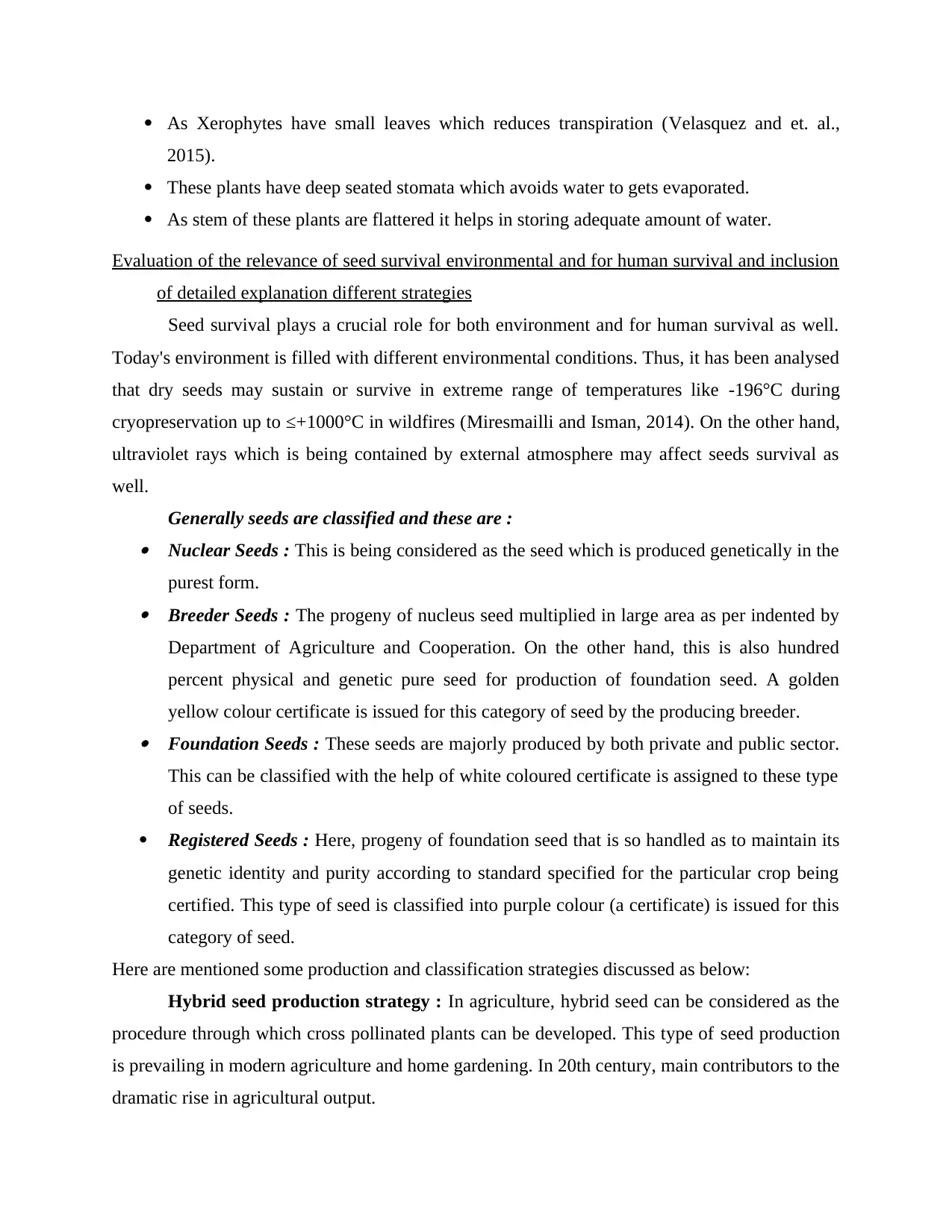
As Xerophytes have small leaves which reduces transpiration (Velasquez and et. al.,
2015).
These plants have deep seated stomata which avoids water to gets evaporated.
As stem of these plants are flattered it helps in storing adequate amount of water.
Evaluation of the relevance of seed survival environmental and for human survival and inclusion
of detailed explanation different strategies
Seed survival plays a crucial role for both environment and for human survival as well.
Today's environment is filled with different environmental conditions. Thus, it has been analysed
that dry seeds may sustain or survive in extreme range of temperatures like -196°C during
cryopreservation up to ≤+1000°C in wildfires (Miresmailli and Isman, 2014). On the other hand,
ultraviolet rays which is being contained by external atmosphere may affect seeds survival as
well.
Generally seeds are classified and these are : Nuclear Seeds : This is being considered as the seed which is produced genetically in the
purest form. Breeder Seeds : The progeny of nucleus seed multiplied in large area as per indented by
Department of Agriculture and Cooperation. On the other hand, this is also hundred
percent physical and genetic pure seed for production of foundation seed. A golden
yellow colour certificate is issued for this category of seed by the producing breeder. Foundation Seeds : These seeds are majorly produced by both private and public sector.
This can be classified with the help of white coloured certificate is assigned to these type
of seeds.
Registered Seeds : Here, progeny of foundation seed that is so handled as to maintain its
genetic identity and purity according to standard specified for the particular crop being
certified. This type of seed is classified into purple colour (a certificate) is issued for this
category of seed.
Here are mentioned some production and classification strategies discussed as below:
Hybrid seed production strategy : In agriculture, hybrid seed can be considered as the
procedure through which cross pollinated plants can be developed. This type of seed production
is prevailing in modern agriculture and home gardening. In 20th century, main contributors to the
dramatic rise in agricultural output.
2015).
These plants have deep seated stomata which avoids water to gets evaporated.
As stem of these plants are flattered it helps in storing adequate amount of water.
Evaluation of the relevance of seed survival environmental and for human survival and inclusion
of detailed explanation different strategies
Seed survival plays a crucial role for both environment and for human survival as well.
Today's environment is filled with different environmental conditions. Thus, it has been analysed
that dry seeds may sustain or survive in extreme range of temperatures like -196°C during
cryopreservation up to ≤+1000°C in wildfires (Miresmailli and Isman, 2014). On the other hand,
ultraviolet rays which is being contained by external atmosphere may affect seeds survival as
well.
Generally seeds are classified and these are : Nuclear Seeds : This is being considered as the seed which is produced genetically in the
purest form. Breeder Seeds : The progeny of nucleus seed multiplied in large area as per indented by
Department of Agriculture and Cooperation. On the other hand, this is also hundred
percent physical and genetic pure seed for production of foundation seed. A golden
yellow colour certificate is issued for this category of seed by the producing breeder. Foundation Seeds : These seeds are majorly produced by both private and public sector.
This can be classified with the help of white coloured certificate is assigned to these type
of seeds.
Registered Seeds : Here, progeny of foundation seed that is so handled as to maintain its
genetic identity and purity according to standard specified for the particular crop being
certified. This type of seed is classified into purple colour (a certificate) is issued for this
category of seed.
Here are mentioned some production and classification strategies discussed as below:
Hybrid seed production strategy : In agriculture, hybrid seed can be considered as the
procedure through which cross pollinated plants can be developed. This type of seed production
is prevailing in modern agriculture and home gardening. In 20th century, main contributors to the
dramatic rise in agricultural output.
Paraphrase This Document
Need a fresh take? Get an instant paraphrase of this document with our AI Paraphraser
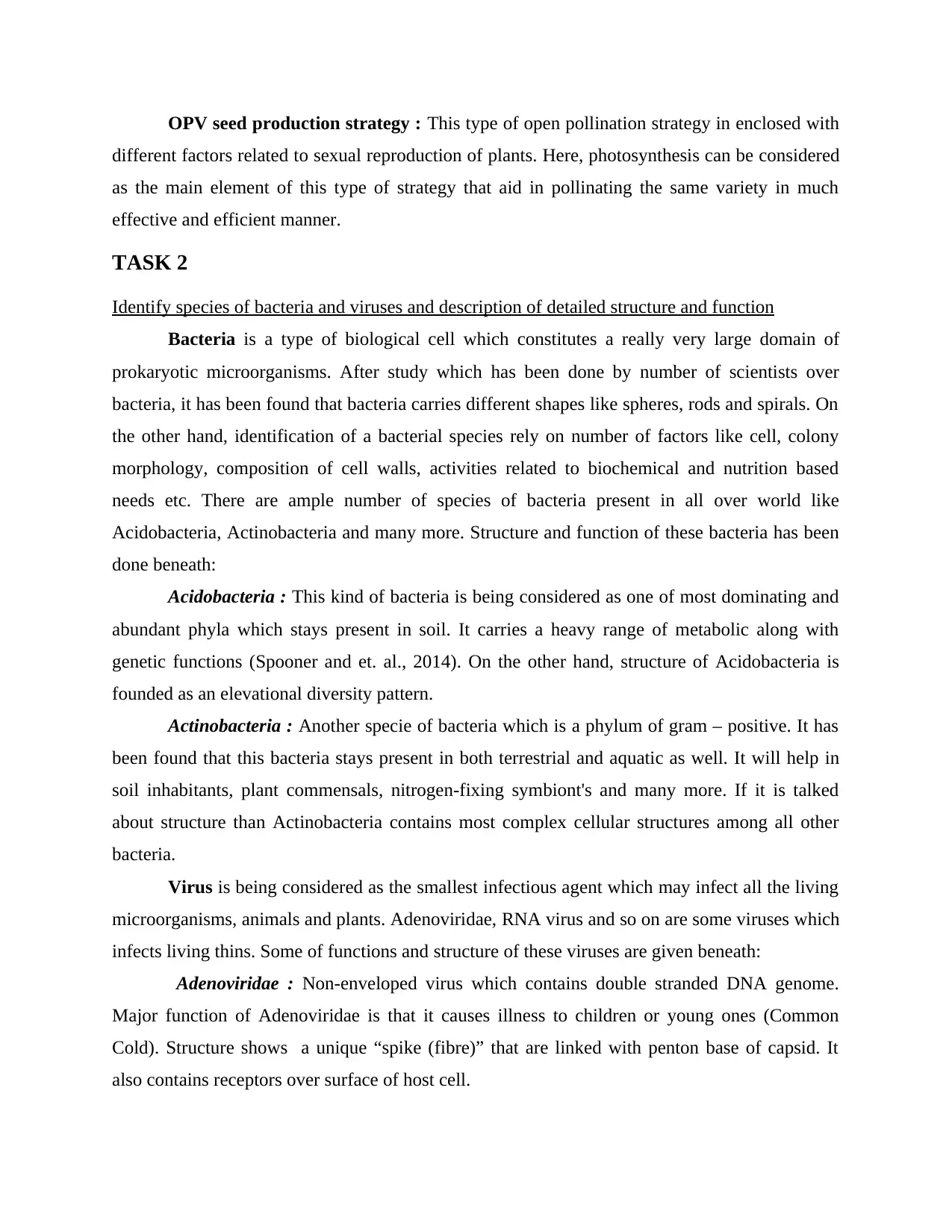
OPV seed production strategy : This type of open pollination strategy in enclosed with
different factors related to sexual reproduction of plants. Here, photosynthesis can be considered
as the main element of this type of strategy that aid in pollinating the same variety in much
effective and efficient manner.
TASK 2
Identify species of bacteria and viruses and description of detailed structure and function
Bacteria is a type of biological cell which constitutes a really very large domain of
prokaryotic microorganisms. After study which has been done by number of scientists over
bacteria, it has been found that bacteria carries different shapes like spheres, rods and spirals. On
the other hand, identification of a bacterial species rely on number of factors like cell, colony
morphology, composition of cell walls, activities related to biochemical and nutrition based
needs etc. There are ample number of species of bacteria present in all over world like
Acidobacteria, Actinobacteria and many more. Structure and function of these bacteria has been
done beneath:
Acidobacteria : This kind of bacteria is being considered as one of most dominating and
abundant phyla which stays present in soil. It carries a heavy range of metabolic along with
genetic functions (Spooner and et. al., 2014). On the other hand, structure of Acidobacteria is
founded as an elevational diversity pattern.
Actinobacteria : Another specie of bacteria which is a phylum of gram – positive. It has
been found that this bacteria stays present in both terrestrial and aquatic as well. It will help in
soil inhabitants, plant commensals, nitrogen-fixing symbiont's and many more. If it is talked
about structure than Actinobacteria contains most complex cellular structures among all other
bacteria.
Virus is being considered as the smallest infectious agent which may infect all the living
microorganisms, animals and plants. Adenoviridae, RNA virus and so on are some viruses which
infects living thins. Some of functions and structure of these viruses are given beneath:
Adenoviridae : Non-enveloped virus which contains double stranded DNA genome.
Major function of Adenoviridae is that it causes illness to children or young ones (Common
Cold). Structure shows a unique “spike (fibre)” that are linked with penton base of capsid. It
also contains receptors over surface of host cell.
different factors related to sexual reproduction of plants. Here, photosynthesis can be considered
as the main element of this type of strategy that aid in pollinating the same variety in much
effective and efficient manner.
TASK 2
Identify species of bacteria and viruses and description of detailed structure and function
Bacteria is a type of biological cell which constitutes a really very large domain of
prokaryotic microorganisms. After study which has been done by number of scientists over
bacteria, it has been found that bacteria carries different shapes like spheres, rods and spirals. On
the other hand, identification of a bacterial species rely on number of factors like cell, colony
morphology, composition of cell walls, activities related to biochemical and nutrition based
needs etc. There are ample number of species of bacteria present in all over world like
Acidobacteria, Actinobacteria and many more. Structure and function of these bacteria has been
done beneath:
Acidobacteria : This kind of bacteria is being considered as one of most dominating and
abundant phyla which stays present in soil. It carries a heavy range of metabolic along with
genetic functions (Spooner and et. al., 2014). On the other hand, structure of Acidobacteria is
founded as an elevational diversity pattern.
Actinobacteria : Another specie of bacteria which is a phylum of gram – positive. It has
been found that this bacteria stays present in both terrestrial and aquatic as well. It will help in
soil inhabitants, plant commensals, nitrogen-fixing symbiont's and many more. If it is talked
about structure than Actinobacteria contains most complex cellular structures among all other
bacteria.
Virus is being considered as the smallest infectious agent which may infect all the living
microorganisms, animals and plants. Adenoviridae, RNA virus and so on are some viruses which
infects living thins. Some of functions and structure of these viruses are given beneath:
Adenoviridae : Non-enveloped virus which contains double stranded DNA genome.
Major function of Adenoviridae is that it causes illness to children or young ones (Common
Cold). Structure shows a unique “spike (fibre)” that are linked with penton base of capsid. It
also contains receptors over surface of host cell.
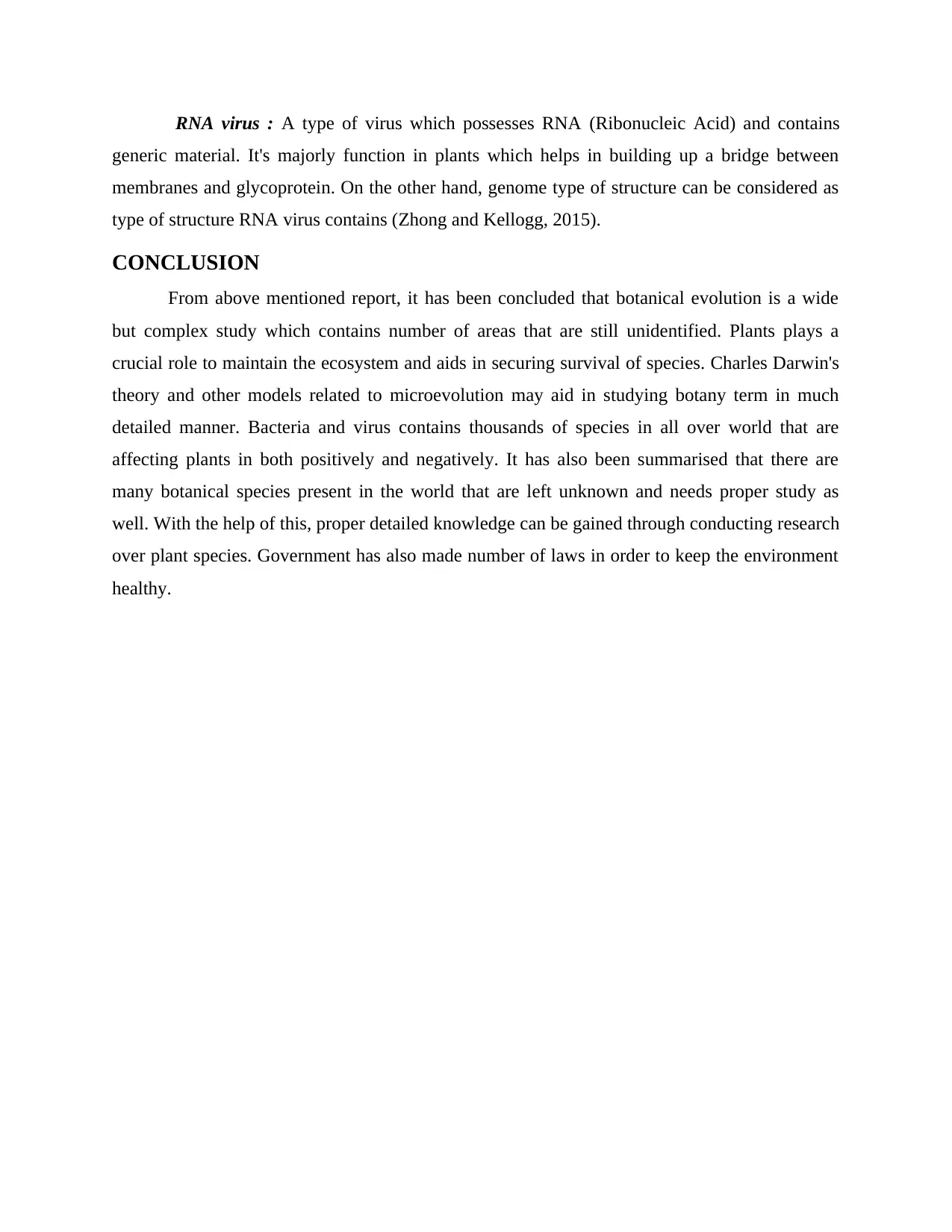
RNA virus : A type of virus which possesses RNA (Ribonucleic Acid) and contains
generic material. It's majorly function in plants which helps in building up a bridge between
membranes and glycoprotein. On the other hand, genome type of structure can be considered as
type of structure RNA virus contains (Zhong and Kellogg, 2015).
CONCLUSION
From above mentioned report, it has been concluded that botanical evolution is a wide
but complex study which contains number of areas that are still unidentified. Plants plays a
crucial role to maintain the ecosystem and aids in securing survival of species. Charles Darwin's
theory and other models related to microevolution may aid in studying botany term in much
detailed manner. Bacteria and virus contains thousands of species in all over world that are
affecting plants in both positively and negatively. It has also been summarised that there are
many botanical species present in the world that are left unknown and needs proper study as
well. With the help of this, proper detailed knowledge can be gained through conducting research
over plant species. Government has also made number of laws in order to keep the environment
healthy.
generic material. It's majorly function in plants which helps in building up a bridge between
membranes and glycoprotein. On the other hand, genome type of structure can be considered as
type of structure RNA virus contains (Zhong and Kellogg, 2015).
CONCLUSION
From above mentioned report, it has been concluded that botanical evolution is a wide
but complex study which contains number of areas that are still unidentified. Plants plays a
crucial role to maintain the ecosystem and aids in securing survival of species. Charles Darwin's
theory and other models related to microevolution may aid in studying botany term in much
detailed manner. Bacteria and virus contains thousands of species in all over world that are
affecting plants in both positively and negatively. It has also been summarised that there are
many botanical species present in the world that are left unknown and needs proper study as
well. With the help of this, proper detailed knowledge can be gained through conducting research
over plant species. Government has also made number of laws in order to keep the environment
healthy.
⊘ This is a preview!⊘
Do you want full access?
Subscribe today to unlock all pages.

Trusted by 1+ million students worldwide
1 out of 13
Your All-in-One AI-Powered Toolkit for Academic Success.
+13062052269
info@desklib.com
Available 24*7 on WhatsApp / Email
![[object Object]](/_next/static/media/star-bottom.7253800d.svg)
Unlock your academic potential
Copyright © 2020–2025 A2Z Services. All Rights Reserved. Developed and managed by ZUCOL.
